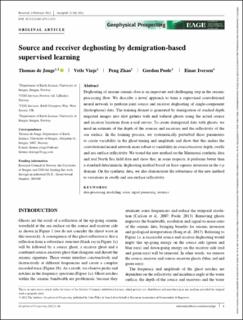Source and receiver deghosting by demigration-based supervised learning
Journal article, Peer reviewed
Published version

Åpne
Permanent lenke
https://hdl.handle.net/11250/3062086Utgivelsesdato
2022Metadata
Vis full innførselSamlinger
- Department of Earth Science [1034]
- Registrations from Cristin [9489]
Sammendrag
Deghosting of marine seismic data is an important and challenging step in the seismic processing flow. We describe a novel approach to train a supervised convolutional neural network to perform joint source and receiver deghosting of single-component (hydrophone) data. The training dataset is generated by demigration of stacked depth migrated images into shot gathers with and without ghosts using the actual source and receiver locations from a real survey. To create demigrated data with ghosts, we need an estimate of the depth of the sources and receivers and the reflectivity of the sea surface. In the training process, we systematically perturbed these parameters to create variability in the ghost timing and amplitude and show that this makes the convolutional neural network more robust to variability in source/receiver depth, swells and sea surface reflectivity. We tested the new method on the Marmousi synthetic data and real North Sea field data and show that, in some respects, it performs better than a standard deterministic deghosting method based on least-squares inversion in the τ-p domain. On the synthetic data, we also demonstrate the robustness of the new method to variations in swells and sea-surface reflectivity.
